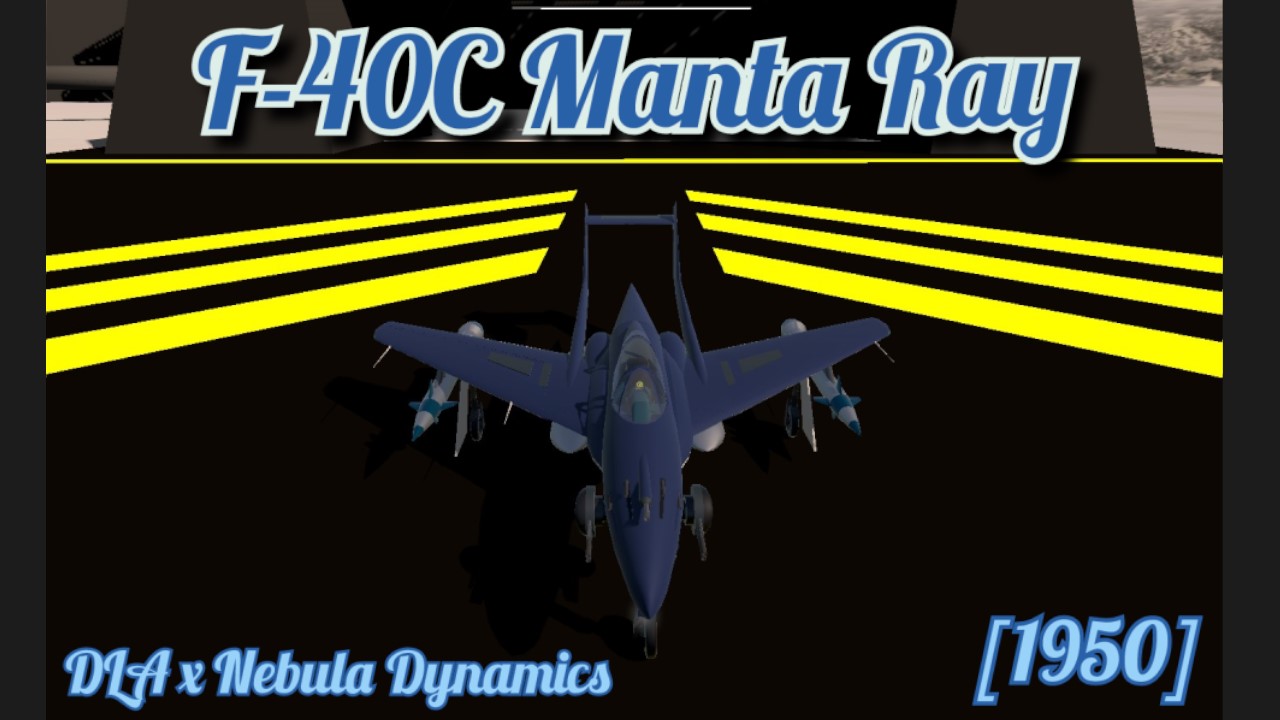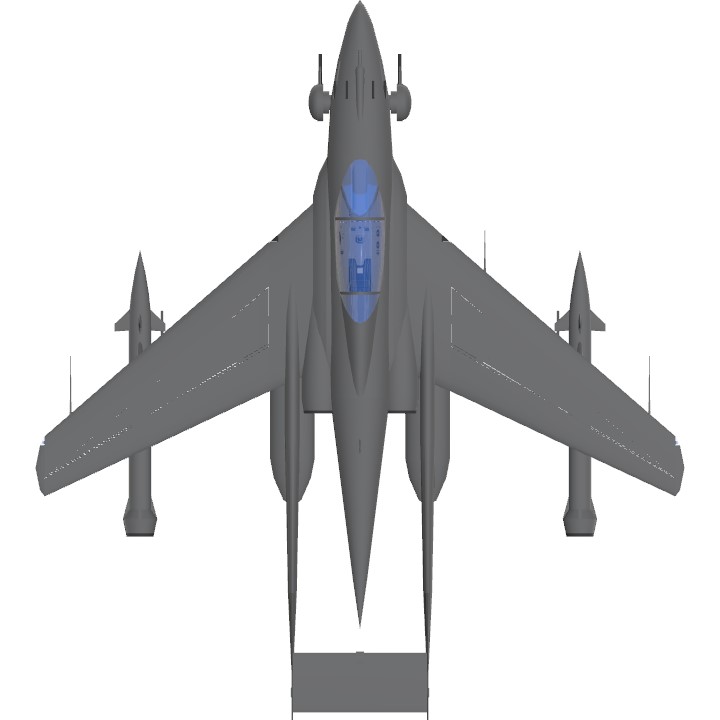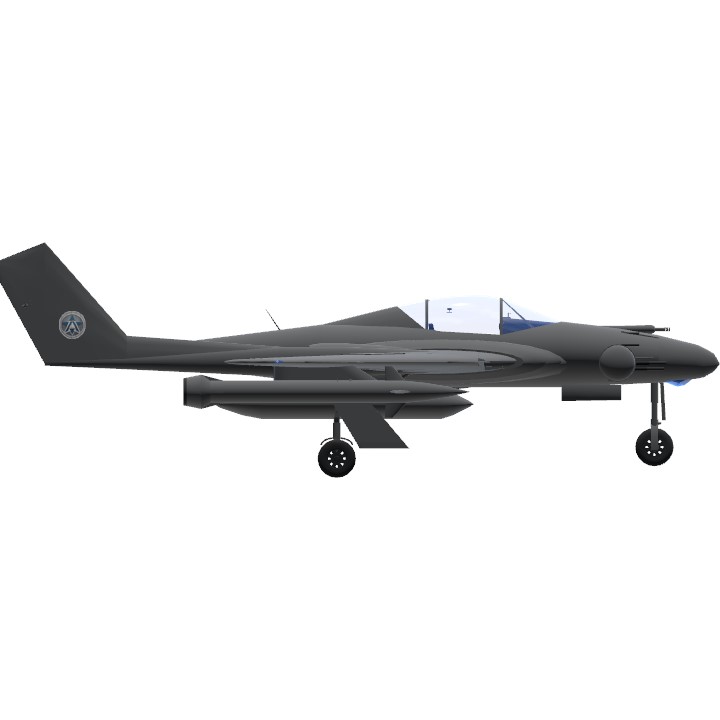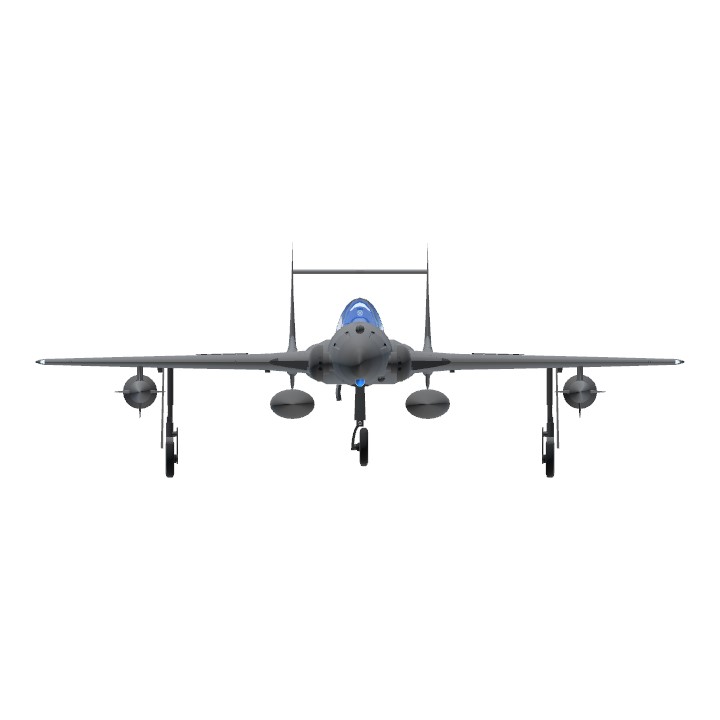Designation: F-40C Manta Ray [Naval Attack Aircraft]
Nickname: The Blue Angel
X-40 MT [Preproduction - 1950]

Brief description and lore:
As the nation of Aretania has become the focus of terrorist attacks, DLA Aerospace Manufacturing Company and Nebula Dynamics presents the
F-40 Manta Ray, an extraordinary aircraft born from a unique collaboration. Developed to safeguard the skies of Aretania, the Manta Ray is the result of combined expertise and a shared vision to serve the people with the finest aircraft the industry has ever known.Aretania found itself under the threat of terrorism that sought to destabilize its peace and security. In response, DLA in partnership with Nebula Dynamics, a consortium of industry-leading manufacturers, together sought to develop an aircraft that would become the epitome of versatility and firepower—the F-40 Manta Ray. Partly inspired by the original design of the F-39A Thunderboa II.
Instructions:
AG1 - Open/Close Canopy
AG2 - NAV Lights
AG3 - Cockpit Lights
AG4 - Jettison All Payload
AG5 - Arresting Hook
AG6 - Jettison Napalm
AG7 - Jettison Rockets
VTOL - Flaps
Afterburners - Engages at 95% Throttle
Engine and Afterburner Modes
- For this model the engines are already set to 'On'. The switches, lights, etc. work the same as the F-39A Thunderboa II.

- Afterburner will engage once the lever labelled "afterburner" has been set to 1 or -1 (Mode 2 or Mode 3, respectively). 0 is the default mode. Mode 3 helps when the extra speed is needed for sustained turns, mode 2 is full afterburner. Max speed without afterburner is roughly 550+ mph, mode 3 up to 620+ mph, and mode 2 up to 700+ mph.
Carrier Landings
Deploy the arresting hook (AG5) and throttle down to 5-2%, extend flaps (VTOL) to 100% down.
- For take off set flaps (VTOL) to 50% down and throttle up.
Turrets and Camera



- The turrets rotate automatically whenever a target is selected. Essentially effective up to 4.5 miles at 1300 ft above ground level. Though primarily made to point downwards to engage ground targets, the turret rotators can be disabled using the switch (indicated below) in order to aim straight ahead.

Reticle

Again, same as the Thunderboa. In a 35 degree dive, going 500+ mph the outermost ring also indicates the estimated impact point of the napalms. The predictor does that job anyway.
Nation of Origin: Grand Monarchy of Aretania
Max Speed (in level flight): 544 mph (875 kph)
at height: 2500 ft (762 m) (without afterburner modes)
Turn Time: 360° in 9 seconds (without all payload)
Rate of Climb: ~ 65.7 m/s
Payload: 576 lbs.
Max Take-off Weight: 15259 lbs.
Max Fuel: 403 gal. (1832 L)
Armament: 4x 35mm Nose Mounted Canon, 2x DLA [RDM] Javelin J-1, 2x Nose Mounted Gun, 2x Nose Mounted Remote Turrets (2x 50mm Canons and 1x Machine Gun Each), 2x Incendraze Inferno-9, "Napalms".
Gallery


First Carrier Landing

Remote Turret Test
- Though similar to the Thunderboa in appearance, the Manta Ray features improved firepower, engines, maneuverability, carrier capability, several design changes (intakes, tail, nose, and cockpit), a nose mounted camera and improved landing gear.
Credits:
Big thanks to S-3 Viking for the turret rotator code and Crabstickx - (Nebula Dynamics) for the aircraft design inspiration.
War Challenge United: S1 - Red Storm Rising -----------<>|>
Specifications
Spotlights
- Aditiaa 2.3 years ago
- GreatWizard 2.3 years ago
- 210100 2.3 years ago
- FartResidue 2.3 years ago
- ToeTips 2.3 years ago
General Characteristics
- Predecessor War Challenge United Season 1: Red Storm Rising(CHALLENGE CLOSED)
- Created On Windows
- Wingspan 35.6ft (10.8m)
- Length 39.5ft (12.0m)
- Height 12.9ft (3.9m)
- Empty Weight 4,130lbs (1,873kg)
- Loaded Weight 6,834lbs (3,100kg)
Performance
- Power/Weight Ratio 3.255
- Wing Loading 27.7lbs/ft2 (135.2kg/m2)
- Wing Area 246.9ft2 (22.9m2)
- Drag Points 945
Parts
- Number of Parts 499
- Control Surfaces 7
- Performance Cost 2,151




